Patience Cards and their Boxes
Patience Cards and their Boxes by Tony Hall.
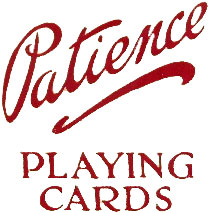
I thought it was about time that I shared my passion for collecting Patience cards. Odd, I know, but someone has to do it. I write, not to enhance the value of my own collection (as if I would), and I don’t need any more competition for the range of interesting items out there still to be acquired. I write because of the delights in finding items of interest, particularly from the 19th century and early decades of the last one. Many are beautifully made, intriguing in design and, at best, very tactile. Most were produced when card playing – socially and individually – was a major pastime in the years before the cinema, television and other diversions. And there are plenty of examples out there at modest prices; £5 -£10 can buy some really interesting pieces.
Let us start at the beginning; patience cards labelled as such, appear to have been produced in three different sizes: miniature, medium and standard. Most producers, in Britain and overseas, appear to comply more or less with the same sizes. Miniatures are roughly 3.2 x 4.5 cm; medium packs vary around 4.2 (5) x 6.7 (7), and standard packs are those familiar for playing whist, bridge and other card games. Although standard-sized packs are sometimes sold with the “patience” label, the many patience games can be played with “ordinary”, standard packs of cards. For this reason, I concentrate here on the miniature and medium-sized cards which were clearly intended solely or primarily for patience play.
By and large it is not the cards themselves which are of interest. There is some variety, but not the same imaginative variation of style and backs familiar to collectors of standard playing cards. The interest comes primarily from the wide variety of boxes and containers in which they were sold and preserved. My collection currently numbers 150 or so items. Few are identical with each other, even where you would expect them to be as they came from the same producer at the same time. The obvious reason for this is that for much of their early history, patience card boxes were largely handmade and each varies according to the skill of the person assembling them at the workshop bench. The factory-produced cards may be identical, but each container is unique and is all the more interesting for that.
It is also true that many of the producers, including the main ones – Goodall & Son and De La Rue in England and the US Playing Card Company in the States – over the years produced a huge variety of box styles with varying materials catering for different tastes and pockets. This was possible because many were hand-made and did not rely on huge investment in production machinery (unlike the cards themselves).
As I can find no other source on this topic (please forgive my ignorance and let me know if I have missed one), I have attempted to classify my collection by the style of design of the container and will identify the manufacturer where this is relevant and known. In the absence of technical descriptions, I have posted my own first attempt at naming the different styles. In many cases it is impossible to be precise about the age of the items, or wholly confident about the manufacturer. I have discussed elsewhere the problems of attribution. I have also written about Poker Patience, including pictures of both miniature and medium-sized boxes designed for this game, so I will not repeat myself here.
Medium-sized sets
I will start with some of the earliest in my collection all of which date from the late 19th century into the first decades of the 20th.
Upright, Hinged Tilted Lid. Here, the defining characteristics are that two packs are contained in an upright position, that the lid is hinged at the back, that the lid is slanted from back to front and that there is a dividing partition separating the two packs.



There are many examples of this style, although today, more than 100 years on from when they were first sold, some of these features may be missing. Frequently the paper hinge has frayed and the lid is detached, and sometimes the central partition is no more. Like all collectors, I like to make sure that all these features are intact before I purchase, unless the item has other features which are rare. Here are a few more examples from Goodall & De La Rue.




Upright, Half Sliding Lid. This next group, also very common, share the characteristics that two packs are contained in an upright position, with a central dividing partition keeping the packs apart. But here, the lid is detached and lifts off. Most have lids which are roughly half the depth of the box but this can vary slightly. This example, by De La Rue, is textured paper on card.


Three further De La Rue examples are made from a variety of textured papers on card.



Two more De La Rue products are beautifully crafted in different types of leather with, presumably, prices to match. The second is retailed by J. C. Vickery “By Royal Appointment to their Majesties the King & Queen” (presumably Edward VII & Alexandra) so they date from sometime in the first decade of the 20th century.


Upright, Full Sliding Lid. This style is similar to those immediately above but the sliding lid covers the entire base containing the cards. Both Goodall and De La Rue produced a variety of versions over the years but, as far as I can tell, they seem always to be in the cheaper, cardboard materials. This means that many examples found today are in less than good condition; pristine examples are rare. I have yet to see one in leather, but am happy to be corrected on this if one turns up.
Here are two boxes by Goodall in the same design (front and side view) but different colours.




This is a rather more ornate version from the same source, together with an equivalent from De La Rue.




De La Rue also offered versions showing sample cards attached outside the box. At least we collectors can be sure that the box set is complete as sold if the cards inside match the packaging!






This rather dull example was, I think, offered by Waddingtons, although it is possible that the cards inside were not part of the original set.


Flat, Poppers. Here, two packs lay side by side in a box sealed with (usually) a plastic-coated popper catch. Here are three examples. Two by Goodall & Son and one by De La Rue, after their take-over of the former company.



Some have drop-down fronts; others are fixed.
Flat, Brass Catches. Here, the box is closed with a double action as a nob is depressed to release the lid. Two types of catch are illustrated below.
Type 1 examples here are both by De La Rue. The catch is on a small tab attached to the lid. The first example is in cardboard overlaid with textured paper; the second is crafted in leather with hallmarked silver corners and lettering (London, DLR, 1907), a silk lining and drop-down front.


Type 2 examples deploy an altogether more basic catch and release attached to a flap which is the same width as the lid. The first example (red) is from Goodall, with paper exterior, silk lining and drop-down front. The second variant (black), almost certainly also by Goodall, provides spaces for four packs, stacked side by side.


One further variant is the hidden brass catch under the leather which coats the box and, when depressed, the lid springs open ►

Flat Flip Top, no catch. Probably the largest category is where the lid flips open unrestricted. Some lids simply lie flat on the sides of the base. In other cases there is an internal panel in the lid which fits snuggly into the base and provides a very tight fit and therefore offers slight resistance to opening. All companies appear to have used this structure but Goodall’s alone offered a huge variety of styles over the years. Here are three examples, identifiable by the familiar logo, albeit in three different versions of it.



All have a central divider to separate the two packs. None, for obvious reasons, have a drop down front!


The best examples are covered in various materials, including linen, paper or leather and are frequently silk lined. Here is a rather splendid example with a scarlet silk interior and hall-marked silver corner flashes dated 1903. The cards inside are by Goodall (1897- 1921) but these may or may not be as originally sold by W. M. Box and Co., Southsea (as a label on the base indicates).


There are endless varieties of flat flip top boxes with no catches from a wide variety of producers.





Hinged Lid (Type 1). This design is also very common. The box lid, usually in cardboard, is hinged at the back and drops forward to cover the whole of the base. This example from Thomas De La Rue from the 1930’s is typical. Most, but not all, have drop-down fronts.


This was the design that contributing companies adopted as gifts in the Wills scheme of 1933. They were made from basic cardboard covered with linen-paper, and came in a wide variety of colours but all conformed to the same basic style. Only the cards identified which manufacturer was responsible.



My personal favourite of this design was a somewhat more up-market product by De La Rue. The slightly dome-topped cardboard case opens to reveal a unique style as shown, containing two gilt-edged Goodall-designed packs and a hardback, bound copy of Angelo Lewis’s “Selected Patience Games” dated 1925. This copy, as you can see, is in pristine condition.


Hinged lid (Type 2). A slight variation of this type has a hinged lid which drops forward to cover only part of the base – only half or slightly less. Here are two examples – one from Waddington, one from Piatnik.


A particularly nice example of this genre was adopted by John Waddington for their set provided for the Orient Line to Australia from the 1950s. Clearly Patience and other card games were frequently deployed to help travellers cope with the six week journey it took to get there in the years before international air travel took over these routes.


Detached lid box. Perhaps the most obvious and basic of all is the cardboard box with a removable lid, here illustrated by De La Rue, probably from the 1960s.


Chest shape. Here two packs of cards are stored on their sides with a divider to separate them and a lid which slides completely over the base. Typically, the base extends slightly beyond the lid when assembled. Goodall produced this basic model in a wide variety of colours, materials and fonts. Some have slightly domed lids.





Waddingtons 'followed suit' in slightly more flamboyant style (clearly a Whist inspired phrase still in common usage).


It is always easier for the collector to identify the manufacturer when the name is printed on the front!
One final example of this chest style varies in that the lid descends only halfway down the base. Beautifully crafted in leather; maker unknown.


This next example is not really a chest but is a personal favourite which cannot be omitted. It is leather, from an unknown maker, in the shape of a doctor’s bag. Sadly, it is missing part of its catch but this doesn’t detract from its evident style.


Travel Sets. There will be an infinite number of these, frequently in leather or faux leather. Here are three examples which do not warrant further explanation.



Double Upright. These refer to boxes where two packs presented side by side and upright. Herewith examples of a flip-top, a full slide top and a partial slide top. The first two are from De La Rue; the third unknown.



Finally, all manufacturers produced a variety of packs in individual boxes, almost always in cardboard. Here are a few examples.




Right: an individual pack of Goodall medium-sized “Linette” cards for retail by W.H. Smith & Son, Ltd.

Miniature sets
Before I present examples of miniature box sets, I recognise the difficulty of appreciating the difference in size between Medium and Miniature. The best I can do here is to show an example of each against a standard sized pack, this one designated for Patience by Bell’s whisky. The medium and miniature boxes are of similar design and materials.

The miniature box is approximately two-thirds the size of the medium box and in each case, of course, the cards inside are very much smaller still.
Miniature boxes are amongst the most attractive of my collections. Despite the difference in size, most match the designs of their larger contemporaries so I will present them, as far as I can, in the same order.
Hinged Tilted lid. We start our revue with an exception. I have not yet come across an example where the cards are upright in a box with a tilted lid. The only tilted lid versions I have found – here are two – include cards on their sides. The left hand example is by Goodall, with a similarly designed De La Rue example on the right.



However there are plentiful examples of the Upringht, hinged non-tilting lid. This Goodall example was produced in a variety of diffent textures as well as colours.



Upright, half sliding lid. This is a far more common and clearly very popular on both sides of the Atlantic. Four examples from Goodall both in textured paper on card and the more expensive leather versions.








The United States Playing Card Company followed Goodall with their “Little Duke, Gold” packs containing two gilt-edged packs.


Upright, Full sliding lid. Another popular style for miniature packs, here by De La Rue and the USPC Co.


Flat, poppers. Here is a Goodall example with a more modern equivalent, albeit lacking the style and quality of the earlier one.


Here, with a similar style of catch, but on a small strap, is an example containing four packs.


Flat, Brass catches. Here two styles of brass catch and both boxes have drop-down front panels.



Flat Flip top, no catch. This, my only example, appears to be of European origin.


Hinged lid (Type 1). A very popular and common style from Goodall and later De La Rue. They all share the hinged back and drop-down front. Some have a finger indent to make it easier to open and they were produced in a wide variety of colours. This particular style had a characteristic border indented into the lid.
Here is one example without the finger space cut out on the lid which makes it rather more difficult to open.


I suspect that this design was modified for the later models seen below which have the rather more user-friendly finger indent on the lid.



This Goodall style, also available in at least three colours (red, green and blue) differed only in that it had no drop-down front.



As yet, I have been unable to find any example of Type 2 where the hinged lid descends only half of the base.
Detached lid box. Very common and, presumably, amongst the easiest and cheapest to produce. Here are two examples. One box containing two packs of Goodall’s famous “Elfin” cards, “for Patience and other games”.


The second is Swiss containing 2 packs of Fabrique Schaffhousoise cards by Muller & Cie. As you can see from the photograph, this box also has four cut-outs on the base to ease the removal of each of the packs.


Chest shape. I have only one example of this style for miniature cards. This one is in thick leather and almost certainly of continental origin and probably a tourist piece, but beautifully made.


Travel Sets. I have seen miniature cards presented in a folder like this one described as a travel set. It is well made in medium-thick leather containing one pack of miniature cards distributed under six different straps.
I understand the argument that this is designed for travel but it makes no sense. This arrangement is more than three times the size of a single pack of cards and therefore does not offer a space-saving option. In any event, miniature cards are tiny and therefore would take up no room in luggage. Yet I can think of no game which requires a pack of cards to be split into six stacks. It remains a mystery. Any and all advice and/or clarifications would be welcome.

Double upright. Three examples. The first two are by the Austrian company, Piatnik – one in plastic; one in card.


The third is from the 1930s; Classique Playing cards by Emlew featuring their famous Scotty dogs.



Individual boxes. While it was usual to sell miniature cards in pairs, it was posible to buy individual packs such as this Elfin example from Goodall.
Designs confined to Miniatures. There are some designs which, in my experience are unique to miniature sets. I have two examples, both from the United States Playing Card Company. The first is a hinged box made from tin and heavily decorated.



The second style is more familiar as a match-box where the “tray” containing the cards slides sideways into the sleeve.

And finally, one of my personal favourites, barely 4.4 x 4 x 4 cm, with a flip-top lid and brass catch. It is beautifully hand-crafted probably by Goodall and illustrates well the gems which are still out there waiting to be found.

Good Hunting!

Addendum - from Peter Burnett
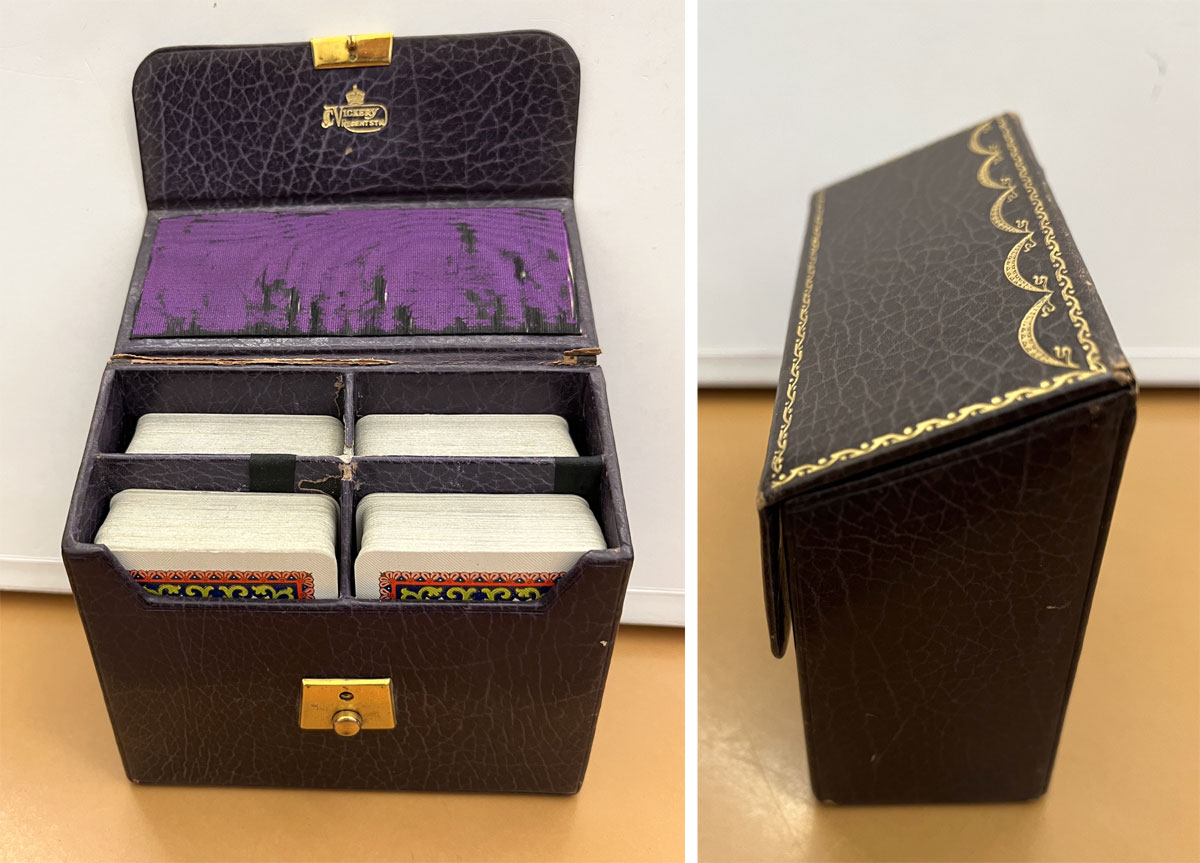
Above: Viceroy patience boxed set for four packs. From the Donald Welsh collection.
By Tony Hall
United Kingdom • Member since January 30, 2015
I started my interest in card games about 70 years ago, playing cribbage with my grandfather. Collecting card game materials started 50 years or so later, when time permitted. One cribbage board was a memory; two became the start of a collection currently exceeding 150!
Once interest in the social history of card games was sparked, I bought a wooden whist marker from the 1880s which was ingenious in design and unbelievably tactile. One lead to two and there was no stopping.
What happened thereafter is reflected in my articles and downloads on this site, for which I will be eternally grateful.

Related Articles
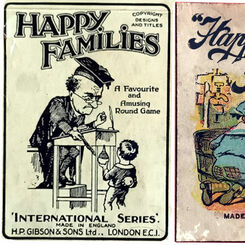
Happy Families
A cautionary tale...
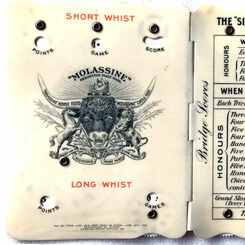
The Molassine Company and its link to Whist and Bridge
A savvy marketing strategy blending Victorian decorative design with Edwardian practicality.
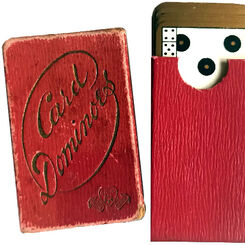
Miniature Card Dominoes
A miniature set of Goodall domino cards (5.9 x 3.5 cms) still in perfect condition.

The Origin of Patience Games in English
Jessel’s Bibliography of works in English on Playing Cards and Gaming describes “The first book on P...

Will’s Cigarettes and Auction Bridge
In 1926 Will’s issued a set of 25 cigarette cards on Auction Bridge, presenting a range of hands ill...
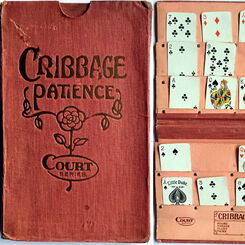
Cribbage Patience or Cribbage Squares
Cribbage Patience or Cribbage Squares, produced by Messrs Edward Mortimer, Halifax and London.

Whist marker boxes
The Camden Whist marker was being advertised by Goodall and son in 1872 as a new product.

Bridge Markers and bridge scoring methods
Bridge Markers and bridge scoring methods 1900-1930
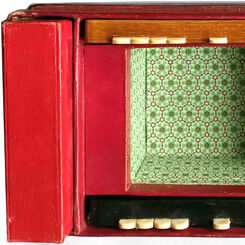
Mystery Objects
I need help in identifying the purpose of this particular piece of card-playing kit.

Kuhn Khan
There is little information available about the early twentieth century card game Kuhn Kahn. It firs...
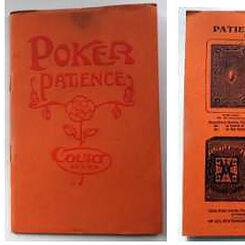
Poker Patience
Poker Patience, according to an early 20th century author, was "introduced so recently as the autumn...
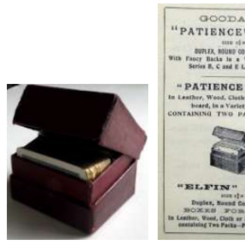
Goodall & Son Patience Boxed Sets
Goodall & Son produced a huge variety of Patience Boxed Sets at different times and for different co...
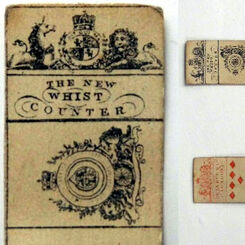
Why do we Collect? My 20 Favourite Items
I suppose people collect for different reasons, rarity, quality, ingenuity of design, sentimental va...
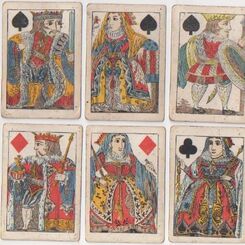
69: My Collection
This is an archive list of my collection. I hope it will be of use and interest to others.

Barribal patience
Waddington’s Patience Cards from the Barribal Series, c.1929.
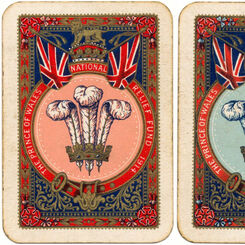
Prince of Wales National Relief Fund 1914
A two-pack patience set produced by Thomas De la Rue on behalf of the Prince of Wales National Relie...
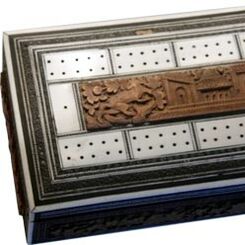
Cribbage Board Collection
A collection of antique and vintage Cribbage Boards by Tony Hall
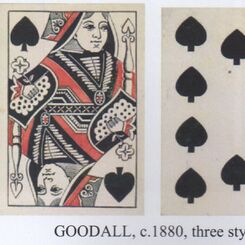
39: Mixed Packs
A number of mixed packs appear for sale from time to time, but it's important to sort out what is me...

Lettische Patience
Karl enjoyed experimenting with design and production and this work was published in 1994 as a 32-ca...

Patience No.21
‘Patience No.21’ is a 52-card miniature deck with double-ended courts and a Joker holding a fan of c...
Most Popular
Our top articles from the past 60 days






















